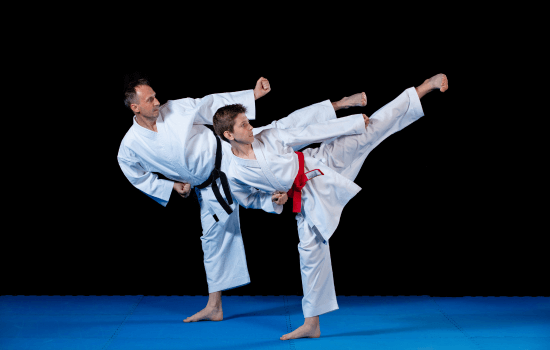Advertisements
Karate is a martial art that combines discipline, strength and technique. While it can take years to fully master it, it is possible to learn the fundamentals quickly with the right tools and approaches.
This guide will help you understand the basic principles and provide you with resources to begin your karate journey efficiently.
Advertisements
Benefits of Karate
Before we dive into the techniques, it is important to know the benefits of practicing karate:
- Improving physical fitness: Strengthens muscles, improves flexibility and increases endurance.
- Mental discipline: Promotes concentration, patience and self-control.
- Self-defense: You will learn how to protect yourself in dangerous situations.
- Self-confidence: Overcoming technical challenges increases your self-esteem.
See also
Advertisements
- Amateur Radio Apps on Cell Phones
- Forgotten languages and codes
- Facts that will make you see the world differently.
- Surprising facts about our biology
- Most incredible and extreme achievements
Fundamentals of Karate
1. Basic Positions
Stances are the foundation of karate, providing stability and balance. Some of the fundamental stances are:
- Zenkutsu Dachi (Forward Attack Stance): Front leg bent and back leg straight, with feet shoulder-width apart.
- Kokutsu Dachi (Backward Defense Stance): Greater weight on the hind leg, with the front leg slightly bent.
- Kiba Dachi (Horse Stance):Legs apart and knees bent, similar to riding a horse.
2. Main Strikes
Karate uses simple and effective strikes. Some starting moves include:
- Oi Zuki (Direct Hit): A straight punch thrown with the fist from the waist forward.
- Gyaku Zuki (Cross Punch): A strike with the arm opposite the forward foot.
- Uraken Uchi (Backhand Strike): Using the upper part of the fist to strike quickly.
3. Basic Blocks
Karate emphasizes both defense and attack. Blocks protect you from your opponent's blows:
- Gedan Barai (Low Block): Deflects attacks directed towards the lower body.
- Age Uke (High Block): Protects against blows to the head.
- Soto Uke (Outward Block): Blocks attacks coming from the side.
4. Kick-offs
Kicks require balance and precision. Start by practicing these:
- Mae Geri (Front Kick): A straight kick using the ball of the foot.
- Yoko Geri (Side Kick): Side kick with the foot, ideal for unbalancing the opponent.
- Mawashi Geri (Circular Kick): A curved kick that hits from the side.
Strategies to Learn Karate Quickly
- Sign up for Online or In-Person Classes: Experienced instructors can correct mistakes and teach you progressively.
- Practice Regularly: Dedicate at least 15-30 minutes daily to perfect your movements.
- Use Apps and Video Tutorials: Platforms such as YouTube or specialized apps offer visual lessons.
- Focus on Technique, Not Speed: It is better to make slow and precise movements than fast and erroneous ones.
- Perform Physical Conditioning Exercises: Strength, flexibility and endurance training complement your progress.
Recommended Resources
1. Learning Applications
- Karate Training (Android/iOS): Offers video lessons and step-by-step guides.
- Martial Arts Mastery (Android): Includes exercises to improve techniques and endurance.
- Kihon Karate App (iOS): Designed for beginners, it covers basic fundamentals and forms.
2. YouTube Channels
- «Karate Dojo»: Detailed classes for all levels.
- «Shotokan Karate Online»: Ideal for learning classic styles such as Shotokan.
- «Martial Arts Athletes»: Educational and motivational content for martial arts.
3. Books
- "Karate-Do: My Way" by Gichin Funakoshi: A classic that details the philosophical and technical principles.
- "Dynamic Karate" by Masatoshi Nakayama: A complete guide to techniques and forms.
- "Essential Karate" by Marc Tedeschi: Perfect for beginners looking for a visual introduction.
Tips for Safe Practice
- Warm Up Before You Begin: Stretch and do gentle exercises to avoid injuries.
- Use an Appropriate Space: Practice in a clear place where you can move freely.
- Listen to your body: If you feel pain, stop and evaluate your technique.
- Consider Protective Equipment: If you train with a partner, wear gloves and pads.

FAQ Section
Is it possible to learn karate without an instructor?
Yes, you can learn the basics through videos and guides. However, an instructor can correct your techniques and prevent bad habits.
How long does it take to learn karate?
Mastering the basics may take a few weeks with consistent practice, but reaching advanced levels takes months or years.
Is a uniform (gi) required to start?
No, but wearing a gi helps you get familiar with traditional training.
Which karate style is best for beginners?
Shotokan and Goju-Ryu are ideal because of their structured focus on the fundamentals.
References
- «Karate-Do: My Way of Life», Gichin Funakoshi.
- "Basic Karate Techniques for Beginners", Black Belt Magazine.
- Downloading apps: Karate Training, Martial Arts Mastery, Kihon Karate App.
